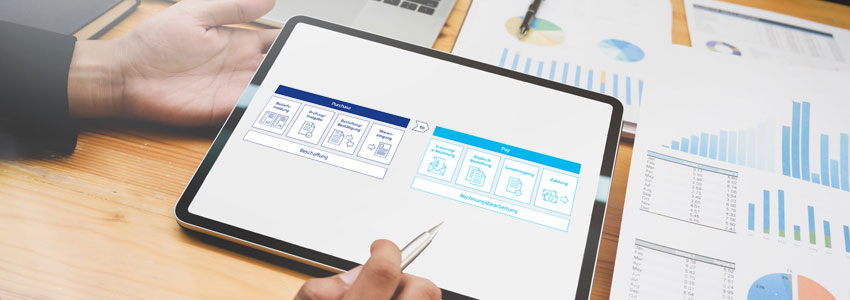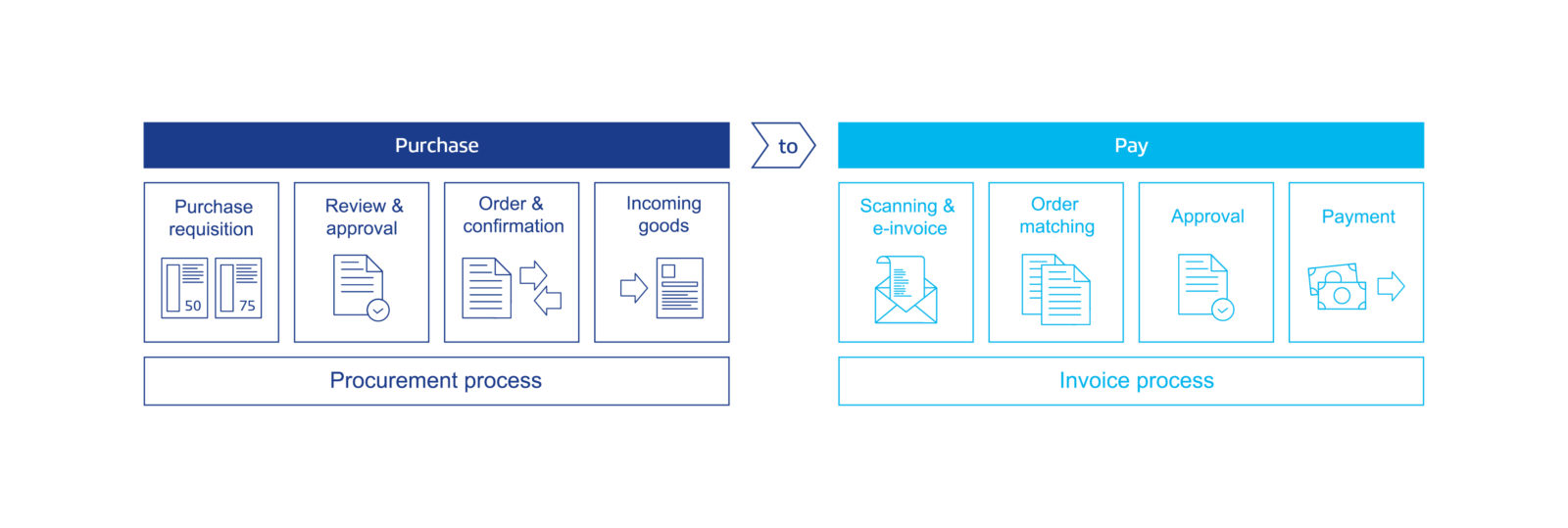The new company standards
Purchase to pay (P2P) and Guided Buying
Despite all attempts at digitalization, companies still spend too much time on non-value-added activities, especially in operational purchasing.

An innovative, complete solution, in which all suppliers are digitally connected, and document and invoice flows can be automated with the help of AI, is the solution.
Synertrade’s Procure-to-Pay solution enables companies to digitally link the procurement processes and their individual steps as well as automating the exchange of data, from the creation of product and service catalogs to the management of incoming invoices from their suppliers. To use this procurement system, companies must first define the central procurement processes, product management and framework parameters. In this way, operational processes can be decentralized and handled as the need arises.
Central characteristics of a complete solution
To ensure that a Purchase-to-Pay system is accepted in the company, the consistency of the process must be guaranteed. Synertrade’s solution completely maps the process from the order, which is transmitted electronically to the supplier, through the processing of the order confirmation, the recording of incoming goods and complaints, and lastly to the processing of incoming invoices.
Incoming invoices can be processed both with and without reference to the order. Purchase orders are entered electronically in the procurement system. The data for catalogue items and free text in the MRO area (C-parts or indirect goods) are directly integrated into the purchase orders by coupling with an ERP syste, in order to transmit a consolidated document to the suppliers via a gateway.
The supplier portal is used for central communication between companies and suppliers. The supplier can create and upload the order confirmation, the goods receipt and the invoicing directly on the platform or communicate via SST connection.
Guided Buying – ordering like in an online shop
Guided buying offers additional added value for orders. If the need arises in the company, a wizard can guide the orderer through the system and to the right product or solution. A use example would be: a defective heating system in need of replacement, a user permitted to select a supplier, and a wizard simplifying the decision-making process for the user. In this case, the user accesses the database in the system, enters the required components of the heating system, adds further features such as manufacturer, size and function. This information is sufficient for the system to display the appropriate service providers or suppliers that are available. The Guided Buying process is as easy for the user as shopping in an online shop thanks to a user-friendly e-procurement system.

Automation in invoice processing
Purchase orders are created, recorded, assigned to an account, then released and transmitted to the supplier electronically in the system. At the same time, the entire goods receipt is recorded, for both partial and final deliveries. In addition, returns and complaints can be entered and documented, and either credit advice notes or credit memo requests can be generated and transmitted to the vendor. Direct integration with subsequent Invoice Verification ensures that invoices and credit memo amounts are monitored and offset.
From this data pool, partial and final invoices can be sent directly, assigned and automatically checked.
This is done via the three-way match:
- Check invoice
- Check order
- Inspection of goods receipt
As soon as all verification components match, the invoice is automatically processed “dark” and booked directly. If there are variances, such as price or quantity, a specific release workflow is started. The process can be further optimized by defining tolerances in combination with percentage and absolute deviations.
Invoices without order reference and cost invoices can also be processed automatically. Through the integration of the contract management, the invoices are compared with the contracts, e.g. for quantity and value contracts both the conditions and the agreed quantities are checked. Here, the data from the invoices is directly assigned to the contracts. This provides a comprehensive overview of the use of the negotiated contracts.
Services are checked against the purchase order on the basis of service entry. Since the effort required for the qualitative check is at the time of service determination, we recommend that you use the self-billing procedure. Here, the service performed is evaluated quantitatively and qualitatively, and a credit memo is issued to the vendor on this basis. This is posted in the ERP system and released for payment. This eliminates the need for a double check of the transaction and ensures that exactly the service that was delivered is paid for.
Thanks to the Camunda Enterprise platform, the invoicing workflow can be adapted with absolute flexibility. The combination of the BPMN and DMN engines offers maximum flexibility with minimum intervention in development and companies can map all verification scenarios.
The engine brings even more advantages:
- The workflows can be graphically modeled and imported directly into the application.
- No customizing for workflow design in the software is necessary.
- Real-time data (runtime) can be separated from historical data (history).
- It is stateless, can be scaled horizontally and is easy to cluster.
Artificial intelligence supports error minimization
An artificial intelligence (AI) component is integrated in the software. The application therefore submits suitable account assignment and posting proposals to the processor over time based on learned conditions.
To ensure that the automated account assignment functions without errors, G/L ( General Accounts) accounts can be clustered according to various criteria, for example, according to material groups, but also according to other company- and industry-related characteristics. It is also possible to subdivide them according to product areas, services, purchases from Germany or abroad, regional or international procurement markets, and purchases of goods from affiliated, related or participating companies.
AI in the system already ensures that account assignment errors are avoided. This is made possible by comparing the data with the master data in the ERP system when the user enters the requirements, thus directly identifying possible deviations and suggesting alternatives.
